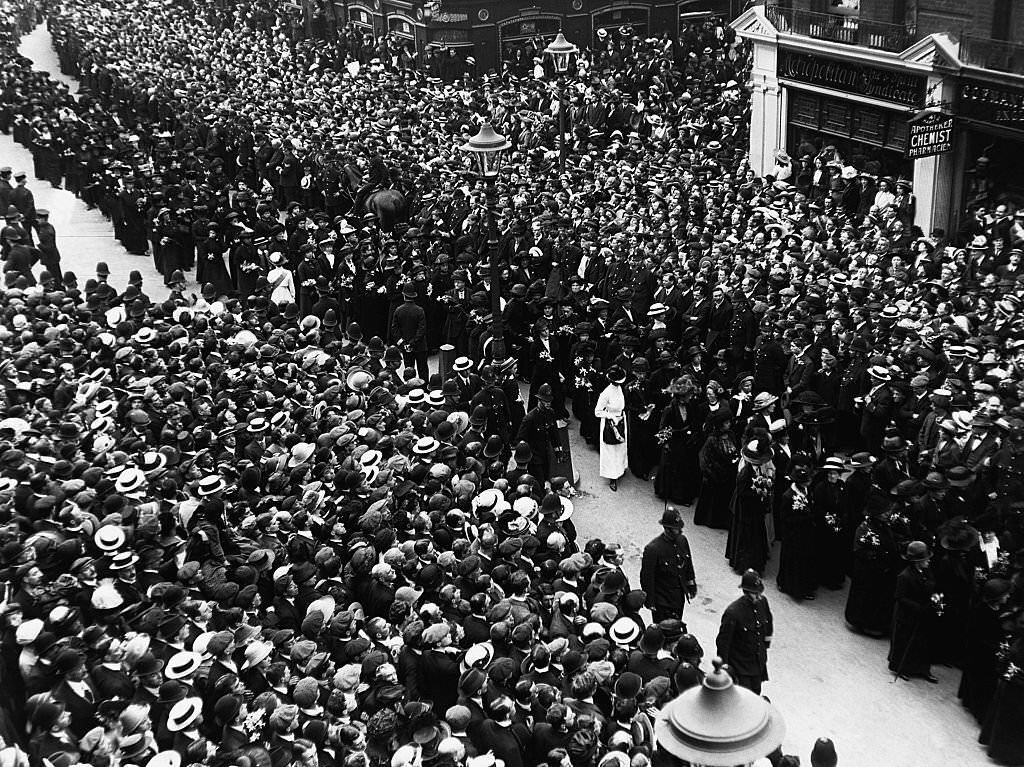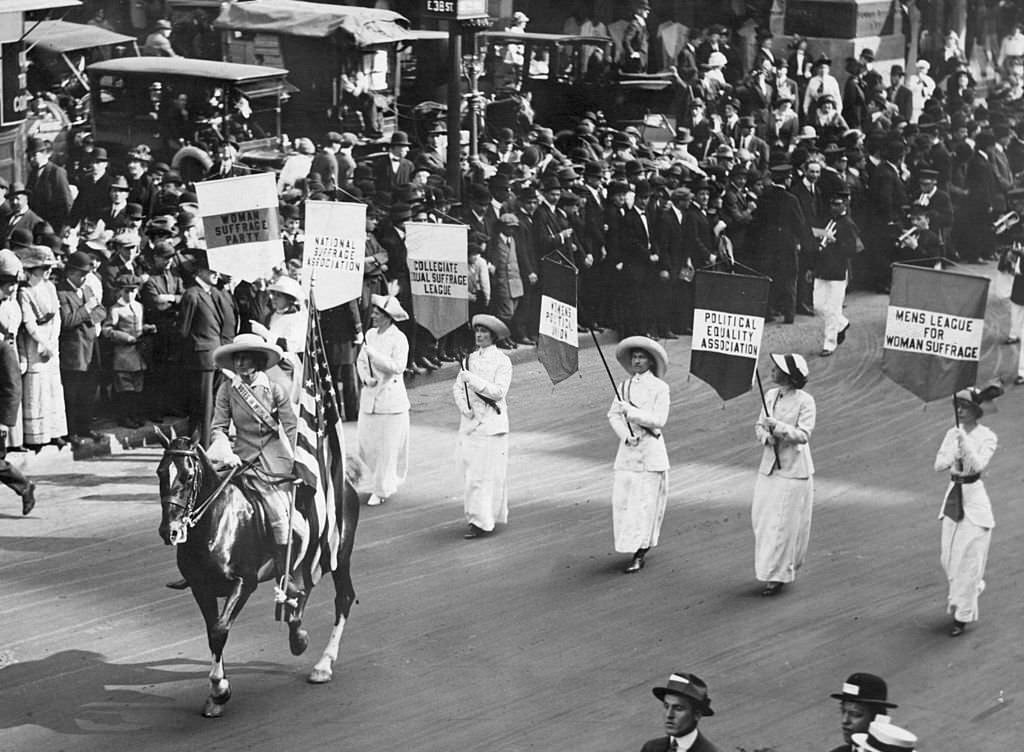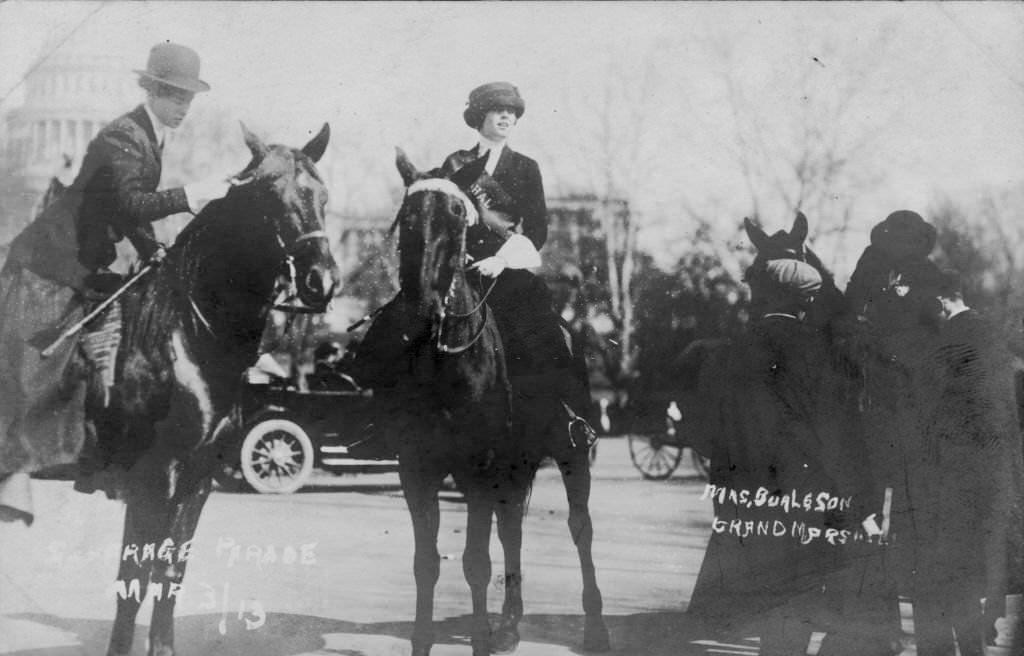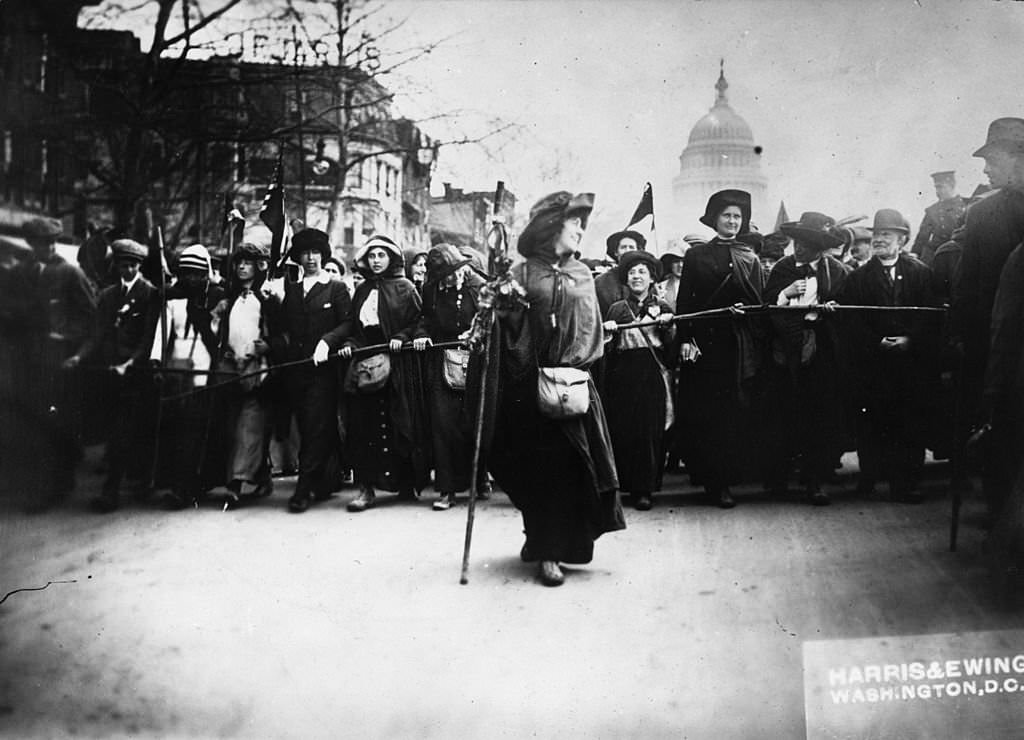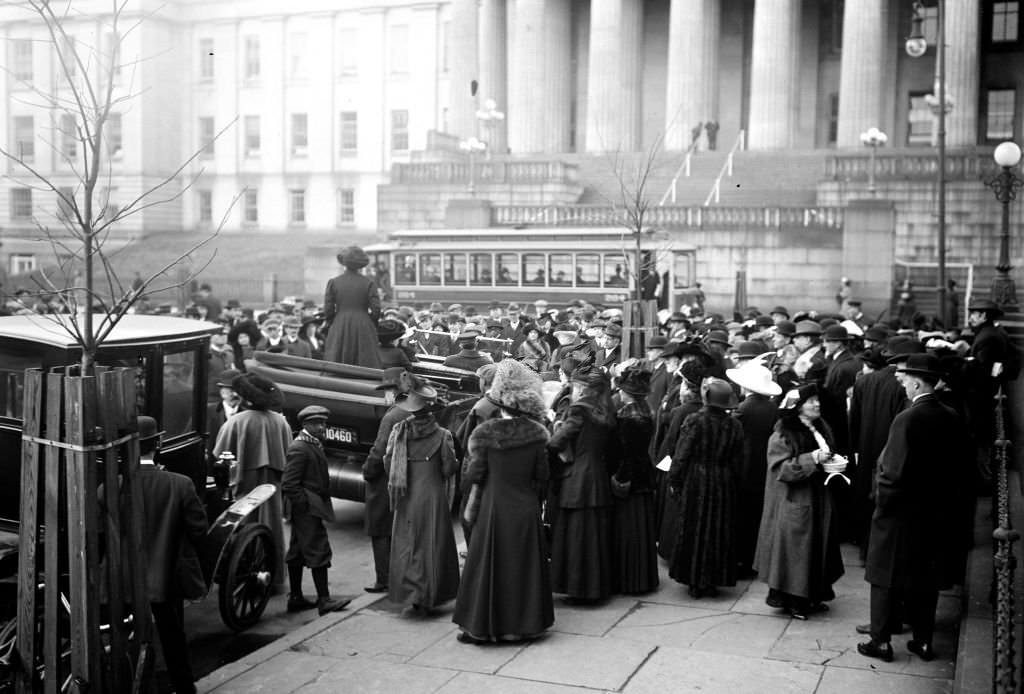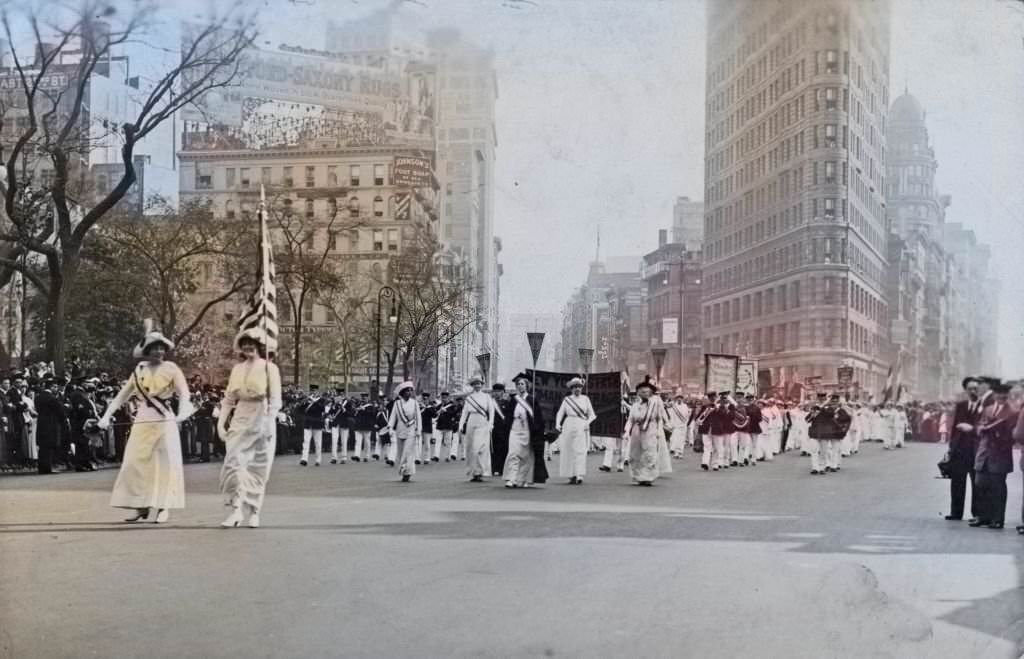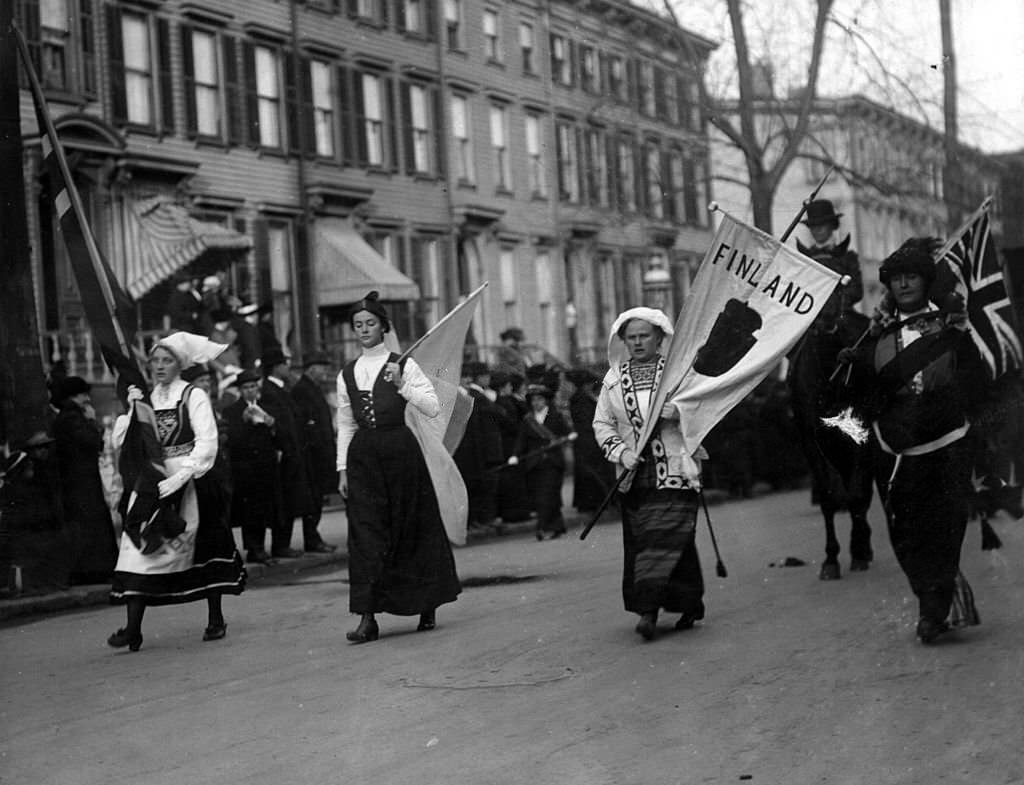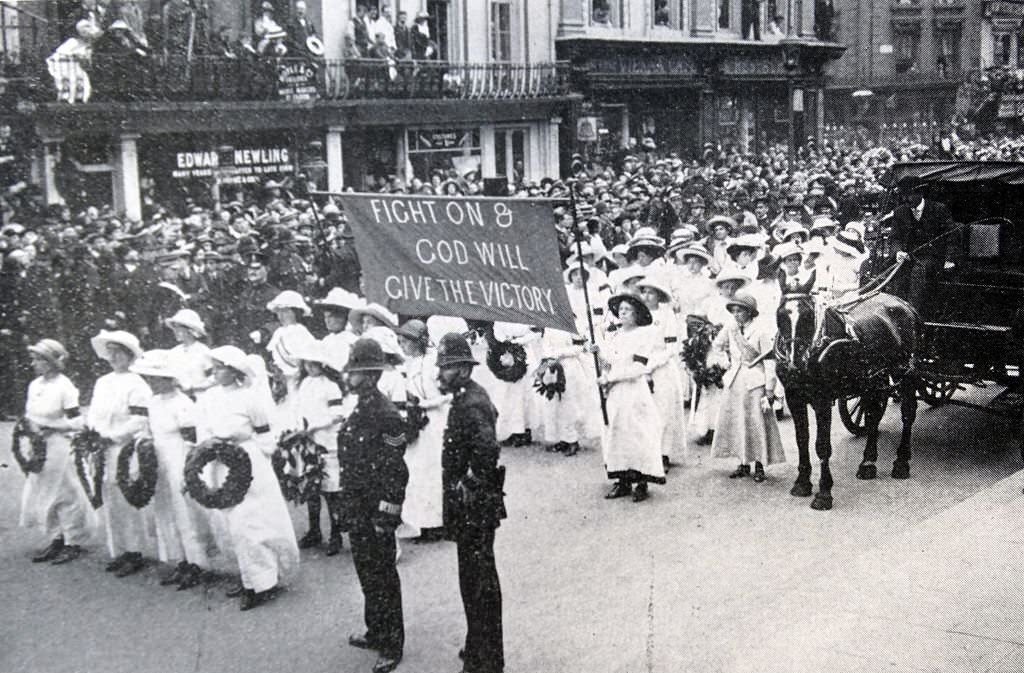Thousands of women gathered in Washington, D.C., on March 3, 1913, to demand the right to vote for women. These women came from all over the country. The movement for women’s suffrage had been waging a fierce battle for more than 60 years, and this gathering was its first major national event. It was organized by Alice Paul and the National American Woman Suffrage Association on March 3, 1913. Hundreds of suffragettes, over 20 parade floats, nine bands, and four mounted brigades marched with the lawyer and activist Inez Milholland astride a white horse. There were thousands of spectators watching the women march from the U.S. Capitol toward the Treasury Building. By strategically holding the parade one day before Woodrow Wilson’s inauguration, the parade organizers maximized attention on the event. It was a successful strategy.
Inez Milholland rode a white horse named Grey Dawn at the front of the procession. Wearing a white dress, a cape, and a golden tiara with the star of hope on top, she rode the horse rather than sidesaddle. Inez was a famous activist, lawyer, and speaker. She was known as “the most beautiful suffragist.” A very photogenic woman, she rode as the herald of the future and embodied the New Woman of the 20th century. She was part of the generation of suffragists who challenged society’s expectations of being a woman and the limitations that those ideas placed on how women dressed and behaved. Feminists fought for more than just the right to vote and full equality.
Some spectators weren’t as kind as others. As police on the parade route failed to help, some marchers were jostled, tripped, and violently attacked. At least 250,000 people streamed into the streets and blocked the parade route instead of staying on the sidewalk. The police stationed along Pennsylvania Avenue were unable or unwilling to control the crowds. Despite their best efforts, the marchers continued to march. As cars and horses tried to clear the street of people, the crowd would fill back in behind them. The progress slowed and then stopped. Marchers found themselves surrounded by hostile, jeering men shouting vile insults and sexual propositions at them. They were manhandled and spat on. Women reported that police officers looked on bemusedly or told them they wouldn’t be in this situation if they had stayed home. Some women fled the terrifying scene, but most were determined to continue. Some of them cried as they faced the ambush. When they could, they ignored the taunts. To defend themselves, some held banner poles, flags, and hatpins. By the end of the day, over 100 women had been hospitalized for injuries due to the incident. The U.S. Army troops cleared the street an hour later so the procession could continue. Despite this, the women did not give up; they completed the parade. They were the subject of significant news stories and congressional hearings due to their experiences. Historians later credited the 1913 parade with re-energizing the suffrage movement.
#1 View of a suffrage parade on a city street flanked by a large crowd, 1913
#2 Woman Suffrage Parade held in Washington, D.C., March 3, 1913 showing a float with banner ‘Women of the Bible Lands’ passing the U.S. Capitol.
#3 Lucy Burns, three-quarter length, seated, facing forward, holding a newspaper in her lap in front of a prison cell.

Lucy Burns, of New York City, who with Alice Paul established the first permanent headquarters for suffrage work in Washington, D.C., helped organize the suffrage parade of Mar. 3, 1913, and was one of the editors of The Suffragist. Leader of most of the picket demonstrations, she served more time in jail than any other suffragists in America. Arrested picketing June 1917, sentenced to 3 days; arrested Sept. 1917, sentenced to 60 days; arrested Nov. 10, 1917, sentenced to 6 months; in Jan. 1919 arrested at watch fire demonstrations, for which she served one 3 day and two 5 day sentences. She also served 4 prison terms in England. Burns was one of the speakers on the "Prison Special" tour of Feb-Mar 1919.
#4 Woman Suffrage Parade, Close-Up, Washington DC,1913
#5 Woman Suffrage Parade, Washington DC, 1913
#6 Two Women Putting Up Poster for Women’s Suffrage Parade, Washington DC, 1913
#7 A scene from the funeral procession of Emily Davison the militant suffragette.
#8 A women’s suffrage parade in Mineola, Long Island, New York, May 24, 1913.
#9 View of a women’s suffrage parade in Mineola, 1913
#10 Grand Marshal Inez Milholland Boissevain leads a parade of 30,000 representives of the various Women’s Suffrage associations, 1913
#11 Mrs John Rogers and Mrs Leonard Hand (right) enroll new recruits for a Woman Suffrage Parade, 1913
#12 A group of ladies carrying the American flag on a Women’s Suffrage Parade, 1913
#13 The women who walked from New York to Washington in February to attend President Woodrow Wilson’s inauguration occupy a position of honour at a Women’s Suffrage Parade
#14 Members of the National American Woman Suffrage Association marching with a banner which publicises their ‘1000 branches organized in 38 states’ at the New York Suffragette Parade.
#15 A police officer supervising a group of suffragettes during a parade in Washington DC, US, 7th April 1913.
#16 Thousands of suffragettes at a suffrage parade on Pennsylvania Avenue, Washington DC, US, 3rd March 1913.
#17 Texan suffragette Jane Walker Burleson (1888 – 1957), Grand Marshal of the parade, on horseback leading suffrage march on Pennsylvania Avenue, Washington DC, US, 3rd March 1913.
#18 Suffragist, socialite, and artist May Jane Walker Burleson, aka “Jennie” May Burleson, center, mounted on her horse while acting as Grand Marshall for the 1913 Washington, DC suffrage parade
#19 Suffrage parade in Washington DC, 1913
#20 Crowds fill a street in Washington D.C. during a suffrage parade in 1913.
#21 Suffragette Parade near Capitol, 1913
#22 Suffragette Dr Julia Holmes Smith, wearing a banner and holding a flag, demonstrating with other suffragists in Chicago, Illinois, February 27, 1913.
#23 American suffragist Rosalie Jones (1883 – 1978) leads a march along Broad Street, Newark, New Jersey, February 12, 1913.
#24 American suffragists Rosalie Jones and Ida Carft lead a march, 1913.
#25 American suffragist Rosalie Jones leads a march, Newark, New Jersey, 1913.
#26 American suffragette Rosalie Jones during the march from New York to Washington DC., 1913
#27 Suffragette marchers arriving in Washington DC from New York after a 250 mile march, 1913
#28 American suffragette Rosalie Jones leading a crowd of protesters up Pennsylvania Avenue, Washington DC, after a march from New York.
#29 American suffragette marchers en route from New Jersey to Washington DC at the time of Woodrow Wilson’s inauguration, 1913
#30 Funerals of Emily Davison.
#31 Alberta Hill on horseback at the Woman Suffrage Parade held in Washington, DC, March 3, 1913
#32 Woman Suffrage Advertising Parade, 1913
#33 Cover of program for the National American Women’s Suffrage Association procession, showing woman n elaborate attire, with cape, blowing long horn, from which is draped a “votes for women” banner.
#34 Women wearing white Edwardian clothing, and sashes, and holding a US flag and pennants, followed by a marching band, taking part in a suffrage parade, 1913
#35 Women wearing white Edwardian clothing, and sashes, and holding a US flag and pennants, followed by a marching band, taking part in a suffrage parade, 1913
#36 Suffragettes matching at a parade, 1913
#37 Suffragettes of the Congressional Union for Woman Suffrage marching during a parade, 1913
#38 Literary Suffragettes, 1913
#39 Suffragettes dressed in their white uniforms carry a banner at the funeral of their fellow campaigner Emily Davison, who died making a protest at the 1913 Epsom Derby.
#40 Lexington Group Suffrage Parade, 1913
#41 A parade for Women’s Suffrage marches down a Manhattan street led by the marshal carrying an American flag, 1913
#42 Some women march and carry flags, others ride horses in a suffrage parade on a street by the Capitol Building in 1913. Washington D.C., USA.
#43 A large parade in support for women’s suffrage, 1913
#44 Suffragette Parade in Washington, 1913
#45 Woman Marching in Parade, 1913
#46 Suffragette Parade in Washington, DC
#47 Matilda Gardner marching in suffrage procession
#48 A large crowd watches Emily Wilding Davison’s funeral procession leaving Morpeth station, 15th June 1913.

She died after stepping out in front of King George V's horse at the Derby at Epsom. On this day every year, up to the late 1960s, suffragettes would visit Morpeth on the 'Emily Davison Pilgrimage'. In 1915, her friend Mary Leigh, far left in the photograph with her head bowed, started the 'Emily Davison Club', and the 'Emily Davison Lodge', whose aim was: 'to perpetuate the memory of a gallant woman by gathering together women of progressive thought and aspiration with the purpose of working for the progress of women according to the needs of the hour'.







